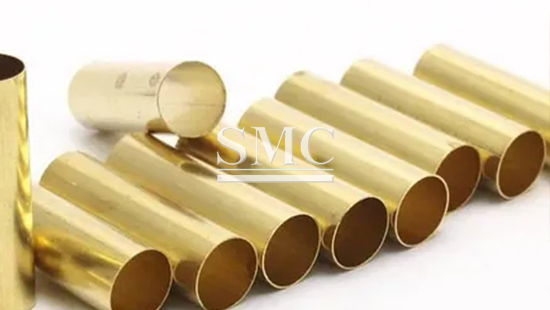Brass is a copper alloy with zinc as the main additive element. It has a beautiful yellow color and is collectively called brass.
The copper-zinc binary alloy is called ordinary brass or simple brass. Ternary or higher brass is called special brass or complex brass. For α brass, as the zinc content increases, both σb and δ increase continuously. For (α + β) brass, when the zinc content is increased to about 45%, the room temperature strength increases continuously. If the zinc content is further increased, the r-phase (solid solution based on the Cu5Zn8 compound) with a more brittle appearance appears in the alloy structure, and the strength decreases sharply. The room temperature plasticity of (α + β) brass always decreases with increasing zinc content. Therefore, copper-zinc alloys containing more than 45% zinc have no practical value. Brass alloys containing less than 36% zinc are composed of solid solution and have good cold workability. For example, brass containing 30% zinc is commonly used to make bullet shells, commonly known as bullet shell brass or seven or three brass. Brass alloys containing between 36% and 42% zinc are composed of solid solution, and the most commonly used is six or four brass with 40% zinc.
The use of ordinary brass is extremely wide, such as water tank belts, water supply and drainage pipes, medals, corrugated pipes, serpentine pipes, condensation pipes, cartridge cases, and various complex shapes of punched products and small hardware. With the increase of zinc content from H63 to H59, they can withstand thermal processing well, and are mostly used in various parts of machinery and electrical appliances, stamping parts and musical instruments. Brass castings are commonly used to make valves and pipe fittings.
The types of brass and their corresponding types are only introduced: in order to improve the corrosion resistance, strength, hardness and machinability of brass, a small amount (generally 1% ~ 2%, and a few up to 3% ~ 4%) are added to the copper-zinc alloy. Very rarely up to 5% to 6%) Tin, aluminum, manganese, iron, silicon, nickel, lead and other elements constitute a ternary, quaternary, or even quinary alloy, which is a complex brass, also known as special yellow copper.
Aluminum Brass: Aluminum can improve the strength, hardness and corrosion resistance of brass, but reduce plasticity, and is suitable for use in condensate pipes and other corrosion-resistant parts of ships.
Tin brass: Tin can improve the strength of brass and corrosion resistance to seawater, so it is called naval brass, which is used as marine thermal equipment and propellers. Able to dissolve in copper-based solid solution, and strengthen the solid solution. However, as the tin content increases, brittle r-phases (CuZnSn compounds) appear in the alloy, which is not conducive to plastic deformation of the alloy. Therefore, the tin content of tin-brass is generally in the range of 0.5% to 1.5%. Commonly used tin brass are HSn70-1, HSn62-1, HSn60-1 and so on. The former is an alpha alloy, which has high plasticity and can be processed under cold and hot pressure. The latter two types of alloys have a (α + β) two-phase structure, and a small amount of r phase often appears. The plasticity at room temperature is not high, and it can only be deformed in the hot state.

Lead brass: Lead can improve the cutting performance of brass. This free-cutting brass is often used as watch parts. Lead is practically insoluble in brass and is distributed on the grain boundaries in the form of free particles. There are two types of lead brass: α and (α + β). Alpha lead brass has the harmful effects of lead and low temperature plasticity, so it can only be cold deformed or hot extruded. (α + β) lead brass has good plasticity at high temperatures and can be forged.
Manganese brass: Manganese has greater solubility in solid brass. Adding 1% to 4% manganese in brass can significantly improve the strength and corrosion resistance of the alloy without reducing its plasticity. Manganese brass has (α + β) structure, and HMn58-2 is commonly used, and the pressure processing performance under cold and hot conditions is quite good.
Iron brass: Iron can improve the mechanical and technical properties of the alloy. The iron content in iron brass is usually less than 1.5%, and its structure is (α + β). It has high strength and toughness, good plasticity at high temperature, and deformable in cold state. The commonly used grade is Hfe59-1-1.
Nickel brass: Nickel can significantly improve the corrosion resistance of brass in the atmosphere and sea water. Nickel can also increase the recrystallization temperature of brass and promote the formation of finer grains. Nickel and copper can form a continuous solid solution, which significantly enlarges the α-phase region. HNi65-5 nickel brass has a single-phase α structure, has good plasticity at room temperature, and can be deformed in the hot state. However, the content of lead must be strictly controlled. Restraint will seriously deteriorate the hot workability of the alloy.
Guest contributors are welcome at the Alloy Wiki.It is a weekly wiki and guide on alloy information and processing technology, while also about the vast array of opportunities that are present in manufacturing. Our team of writers consists of a Machining Material Supplier / Machinist / Tool and Die Maker, a Biomedical Engineer / Product Development Engineer, a Job Development Coordinator / Adjunct Professor, and a President and CEO of a manufacturing facility.
Link to this article:Types of Brass and Performance
Reprint Statement: If there are no special instructions, all articles on this site are original. Please indicate the source for reprinting:Alloy Wiki,thanks!^^


